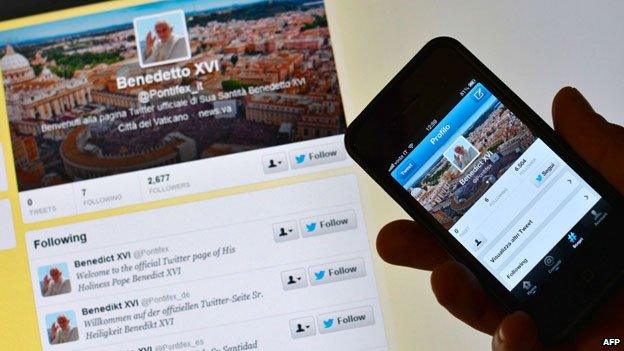Who, What, Why: Will the Pope's tweets be infallible?
- Published

The 85-year-old Pope Benedict will make his debut on Twitter in just over a week, reducing to 140 characters the kernel and core of his teaching. Will these be the first infallible tweets?
Vatican pronouncements are not renowned for their brevity, and it's going to be a challenge for Pope Benedict and his new media aides to craft a new condensed style of papal talk.
Wordy and theologically dense homilies and speeches peppered with biblical references are more the papal style, made for desktops - or tablets perhaps - rather than smartphones.
But what kinds of messages will his Holiness be tweeting?
Monsignor Paul Tighe, the Irish priest in charge of the Vatican's new media department, tells me that whenever the Pope makes an important speech or delivers a homily, or writes a significant document, a "Twitter version" will also be prepared to encapsulate his thought.
There are many forms of papal communication including:
encyclical (meaning "circular") letters, devoted to some particular aspect of Catholic doctrine
papal bulls, solemn documents authenticated with a metal seal and rarely used these days
the motu proprio, a papal decree issued "on the Pope's own initiative"
Every year the Pope also makes hundreds of speeches to ambassadors, pilgrims, professional groups and to the crowds which gather in Saint Peter's Square every Sunday, and at his General Audience most Wednesdays.
But Twitter will definitely not be used as a platform for delivering dogma - authoritative definitions of the core principles of the Catholic faith.
"It's just like the Pope having a private conversation with someone," explains Archbishop Claudio Celli, president of the Pontifical Council for Social Communications.
"There will be no dogmatic aspect to Papal tweets."
This, in turn, means the tweets will not be infallible.
The dogma of papal infallibility, as defined by the First Vatican Council of 1870, states that the Pope is preserved from the possibility of error when, in the exercise of his office as shepherd and teacher of all Christians, he defines a doctrine regarding faith or morals to be held by the whole Church.
He also has to be speaking "ex cathedra", or "from the chair" of Saint Peter, the first Pope, a metaphor for Benedict's position as official teacher of Catholic doctrine. In the ancient world the chair was the symbol for the teacher, and remains so today for university professors.
It is rare today for any Pope to claim that he is speaking infallibly, although it became a rule during the reign of the late Pope John Paul II (which has continued during the current papacy) that the pontiff can declare that any given controversial topic - such as the ordination of women priests, or a relaxation of the celibacy rule - may no longer be a subject for discussion by church leaders.
Such a topic is simply declared taboo or closed. It is therefore unlikely that Pope Benedict will ever himself tweet "No women priests or bishops".
The Pope is taking to Twitter because the Vatican feels driven to respond to the growing number of defections from the Catholic Church in an ever more secularised Europe. He wants to reach out personally to millions of young Catholics in Africa, the fastest growing continent in terms of Catholic believers, and also in Asia and Latin America.
Although his @Pontifex, external account will be in English, there will also be versions available in French, German, Italian, Spanish, Portuguese, Polish, Arabic and eventually in Chinese (@Pontifex_fr and so on).
Pope Benedict, who prefers to write everything in longhand, will not himself be involved with touch screens or keyboards. But he will personally sign off every tweet sent in his name.
"Once the Pope has personally approved the @Pontifex tweet, someone else will send it mechanically from a computer within the Vatican Secretariat of State," Monsignor Tighe says. In order to keep them simple, papal tweets will not contain hashtags, he adds.
Although some leading Vatican cardinals have opened personal Twitter accounts, they are the exception rather than the rule within the Holy See, which traditionally commits all important communications to hard copy.
In fact very few computer terminals within the Vatican bureaucracy have direct access to the world wide web, for security reasons, though the Vatican has its own intranet.
@Pontifex is currently following only @Pontifex_fr and the other translated versions. As of noon on Tuesday the account had 359,000 followers.
Ladbrokes, the betting agency, says the odds are on that the Pope will have a million followers by the end of the year. On the other hand, it doesn't see him exceeding Lady Gaga's 31 million followers by the end of 2013 - the odds are 8-1.
You can follow the Magazine on Twitter, external and on Facebook, external